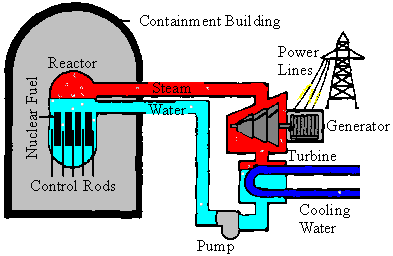
The fuel for nuclear power plants typically follows four major steps: mining and milling, conversion, enrichment, and fabrication.
Mining and milling
Uranium is mined by traditional methods including surface or underground mining techniques. The raw ore is sent to a mill where the ore is crushed and ground. It is leached in sulfuric acid to separate the uranium from the waste rock. It is then precipitated as uranium oxide (U308, or "yellowcake").
Conversion
Because uranium needs to be in the form of a gas before it can be enriched, the U308 is converted into the gas uranium hexafluoride (UF6) at a conversion plant.
Enrichment
Uranium occurs in nature mostly as a U238 isotope, with only 0.7% as U235. However, most nuclear reactors require the more fissionable U235. Therefore, the enrichment process increases the U235 isotope from 0.7% to about 3.5% or slightly more. The leftover material is lower in U235 and is called "tails" or "tailings" -- it is mostly U238. The first enrichment plants used the gaseous diffusion process (the U-235 gas travels diffuses slightly faster than the U238 ), but more modern plants mostly use the centrifuge process. Research is being conducted into laser enrichment.
Fuel fabrication
Enriched UF6 is transported to a fuel fabrication plant where it is converted to uranium dioxide (UO2) powder and pressed into small pellets. These pellets are inserted into thin tubes, usually of a zirconium alloy or stainless steel, to form fuel rods. The rods are then sealed and assembled in clusters to form fuel elements or assemblies for use in the core of the nuclear reactor.
For more on the construction of nuclear power plants, see the module below.
Test your knowledge with a: quiz
For more information, try: radiation
The process starts with the nuclear fuel in the reactor. The process depends on the presence of a moderator such as water. The moderator slows down high speed neutrons (called thermal neutrons) so that the neutrons are able to strike the Uranium-235 nuclei. The U-235 isotope fissions (or splits), producing heat in a continuous process.
In order to stop this process, control rods are dropped into the reactor in between the fuel rods. Control rods have the characteristic of being able to absorb neutrons without fission occuring. Thus, control rods can stop or slow down the rate of fission. In the boiling water reactors shown below, the temperature and pressure conditions are desgined to allow the water to boil, thus producing steam.
As in fossil-fuel burning electricity generating plants, the heat is used to produce steam to drive a turbine and an electric generator. To maintain efficient nuclear reactor performance, about one-third of the spent fuel is removed every year or so, to be replaced with fresh fuel. The water returning to the reactor must be cooled enough to convert the steam back into water.
In the diagram below of a boiling water reactor, the nuclear process is housed in a containment building that is designed to contain radiation. However, in the boiling water reactor, if steam escapes from the turbine, there could be a release of radioactive steam.
Boiling Water Reactor:

Because of concerns about the release of radioactive steam, the pressurized water reactor shown below introduces a new design feature: the secondary loop. The primary loop stays within the reactor core but is used to heat up the secondary loop. The secondary loop turns the turbine as before, but because it is not in direct contact with the reactor core, any steam released from this design should not be radioactive steam.
Pressurized Water Reactor

Test your knowledge with a: quiz
For more information, try: radiation
Spent fuel storage
Spent fuel rods taken from the reactor core are highly radioactive and give off a lot of heat. They are therefore stored in special ponds which are usually located at the reactor site, to allow both their heat and radioactivity to decrease. The water in the ponds serves the dual purpose of acting as a barrier against radiation and dispersing the heat from the spent fuel. Spent fuel can be stored safely in these ponds for long periods. The longer it is stored, the easier it is to handle due to decay of radioactivity. There are two alternatives for spent fuel: reprocessing, and final disposal.
Reprocessing
Spent fuel still contains approximately 96% of its original uranium, of which the fissionable U-235 content has been reduced to less than 1%. About 3% of spent fuel comprises waste products and the remaining 1% is plutonium (Pu) produced while the fuel was in the reactor and not "burned" then. Reprocessing separates uranium and plutonium from waste products (and from the fuel assembly cladding) by chopping up the fuel rods and dissolving them in acid to separate the various materials. Recovered uranium can be returned to the conversion plant for conversion to uranium hexafluoride and subsequent re-enrichment. The reactor-grade plutonium can be blended with enriched uranium to produce a mixed oxide (MOX) fuel*, in a fuel fabrication plant.
Final disposal
The waste forms envisaged for disposal are vitrified high-level wastes sealed into stainless steel canisters, or spent fuel rods encapsulated in corrosion-resistant metals such as copper or stainless steel. The most widely accepted plans are for these to be buried in stable rock structures deep underground. Many geological formations such as granite, volcanic tuff, salt or shale will be suitable. The first permanent disposal is expected to occur about 2010. Most countries intend to introduce final disposal sometime after about 2010, when the quantities to be disposed of will be sufficient to make it economically justifiable.
Test your knowledge with a: quiz
For more information, try: radiation